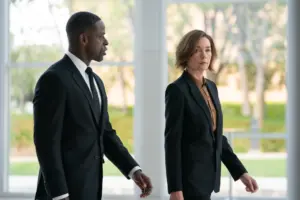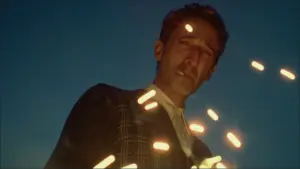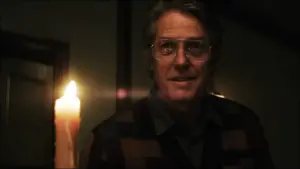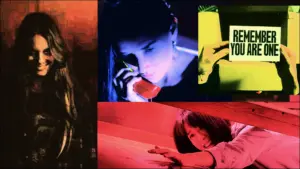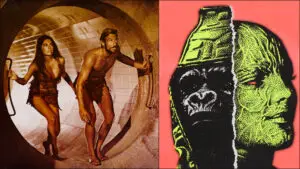Jane Schoenbrun’s first feature, We’re All Going to the World’s Fair (2021), was one of my favorite movies of the past five years, so I had high expectations for the writer-director’s follow-up. Schoenbrun, a nonbinary transgender filmmaker who uses they/them pronouns, is a vibe-forward artist whose work generates unsettling emotional electricity with minimal plot and character. Their films are all melancholy mood and queer subtext.
We’re All Going to the World’s Fair cooked up a heaping helping of fresh, low-budget horror from internet creepypasta meme culture. That film was at the same time a clear-eyed deconstruction of the way gender identities function online and a deeply personal portrait of what it feels like to be excluded from the gender binary.
In their new film, I Saw the TV Glow, Schoenbrun continues to chronicle the specific emotions and experiences of gender transitioning. Paying attention to their films’ pronouns, the “we” in We’re All Going to the World’s Fair signals an interest in collective identity and the way online discourse is like a shared hallucination that can get inside your brain and reprogram you like a virus. Now in I Saw the TV Glow, the “I” suggests a film about the private side of this phenomenon — and how works of media can touch something only half-conscious deep within one’s inner identity, a secret that can become alienating and isolating if kept hidden.
The story follows Owen (Justice Smith of Detective Pikachu and Dungeons and Dragons: Honor Among Thieves), a lonely and awkward teenager who meets Maddy (nonbinary actor Brigette Lundy-Paine of Netflix’s Atypical), his small-town high school’s lesbian misfit. Maddy introduces Owen to a very 1990s Young Adult supernatural horror TV show called The Pink Opaque. The show has obvious parallels to real life shows of the period like Buffy the Vampire Slayer and Nickelodeon’s Are You Afraid of the Dark?, not to mention plenty of Twin Peaks influence. Owen’s strict parents don’t allow him to watch the show. His mom protests that it airs after his bedtime, and his dad (played by nu metal rap-rocker Fred Durst, of all people!) says it’s “a show for girls.” So Maddy surreptitiously passes Owen homemade VHS tapes, which he devours alone in his room.

It is clear even to my cisgendered eye that Owen feels a mysterious and growing connection with The Pink Opaque’s lead character Isabel. Indeed, the actor who plays Owen as a middle schooler (Ian Foreman) has a strong physical resemblance to the actor who plays Isabel (Helena Howard). They have the same caramel-color skin tone, wide mouth, and loose kinky hair. She could be his sister. Or….? (If you know, you know.)
Owen confesses that The Pink Opaque “feels more real than real life,” and Schoenbrun’s film itself blurs the line between the reality of Owen’s story, his memories, and his imaginary fears and dreams. It becomes increasingly difficult for Owen – and us – to tell what exactly is going on. Maddy, who also feels suffocated by their small town, invites Owen to run away with her. The main question of the plot is whether he will go. He wants to start a new life with her, to leave his family behind, but he is afraid. He’s afraid of the unknown, afraid of what his feelings might mean, but also, you know, afraid of all the weird stuff he’s been seeing. It’s a horror movie, after all.
I have to admit, as hyped as I was to see I Saw the TV Glow, I didn’t fall in love with it immediately. I found the film so puzzling that I had to sit with it for a few days to process the experience. It’s not a spoiler to say Schoenbrun’s film aims to capture the feeling of gender dysphoria. As a cisgendered man I can’t personally relate to that, yet We’re All Going to the World’s Fair did manage to generate a real emotion of disorientation and discomfort in me as a viewer. I didn’t feel the TV Glow as deeply. I get that the unresolved ending of Owen’s story is intentionally designed to evoke an abruptly canceled TV series, but the narrative fracture left me cognitively bewildered more than emotionally moved.
Still, Schoenbrun continues to be the reigning queen of vibes. Their films are mysterious and Lynchian. I Saw the TV Glow wants to operate as a trans allegory, but it is even more fundamentally a cinematic expression of Schoenbrun’s personal experience and private subconscious, just as David Lynch’s films are. And like Lynch, when Shoenbrun excavates their subconscious, the unearthed images are hypnotically terrifying and hauntingly beautiful.
The most Lynchian aspect is the film’s musicality. I don’t only mean the well-curated soundtrack and the live band performances, including a cameo by quintessential “sad-girl music” artist Phoebe Bridgers – which pays homage to both the roadhouse from Twin Peaks and The Bronze from Buffy. More than these literal musical elements, Schoenbrun brings a deeper musicality to the film. The mood of the whole piece is an embodiment of that sad/dreamy shoegaze vibe Lynch and composer Angelo Badalamenti curated for singer Julee Cruise and others, music with a dreamlike melancholic sound and unmelodic vocals shrinking behind a waterfall of atmospheric synths. Shoenbrun builds an entire cinematic language out of the feeling of that music.
Even if I Saw the TV Glow can be difficult to parse for those of us outside the trans community, it has such an exciting and original viewpoint and aesthetic, it is worth taking a look.














